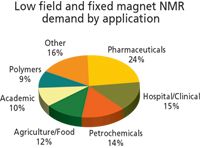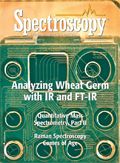Market Profile: Low-Field and Fixed Magnet NMR
The high-flying field of nuclear magnetic resonance (NMR), which is continuing to see strong growth as it approaches the $1 billion mark in annual market revenues, overshadows the market for low-field and fixed magnet NMR. These systems are far simpler and less expensive than the larger systems many have come to think of when they hear the term NMR. The range of applications for low-field and fixed magnet NMR is vast, which is contributing to strong growth in demand.
Market Profile: Low-Field and Fixed Magnet NMR
The high-flying field of nuclear magnetic resonance (NMR), which is continuing to see strong growth as it approaches the $1 billion mark in annual market revenues, overshadows the market for low-field and fixed magnet NMR. These systems are far simpler and less expensive than the larger systems many have come to think of when they hear the term NMR. The range of applications for low-field and fixed magnet NMR is vast, which is contributing to strong growth in demand.
Low-field and fixed magnet NMR instruments, which include time-domain NMR, utilize a relatively small magnet that typically is capable of powers of under 100 MHz. These magnets can be incorporated into a benchtop instrument, or in some models, they are designed as a separate module that can be located out of the way. This is in stark contrast to the often massive superconducting magnets used in moderate- to high-field NMR, which operate anywhere from 300 MHz to powers approaching 1000 MHz.

Low field and fixed magnet NMR demand by application
The range of applications for these low-field and fixed magnet NMR systems is very diverse, and generally falls into quality control and industrial uses. One of the more common applications is the inspection of toiletry and cosmetic products, such as fluoride levels in toothpaste, which falls into the broader category of pharmaceuticals. However, such NMR instruments also are used widely in the agriculture and food, and petrochemicals and polymers industries. Recent instrument introductions that allow the analysis of small living animals has helped create major demand from clinical research laboratories as well. The market for these instruments is estimated to break $70 million in 2007, and is expected to continue to see strong single-digit growth.
The foregoing data were based on SDi's market analysis and perspectives report titled Edition Global Assessment Report, 9th Edition: The Laboratory Life Science and Analytical Instrument Industry, September 2006. For more information, contact Stuart Press, Senior Consultant, Strategic Directions International, Inc., 6242 Westchester Parkway, Suite 100, Los Angeles, CA 90045, (310) 641-4982, fax: (310) 641-8851, www.strategic-directions.com.641-4982, fax: (310) 641-8851, www.strategic-directions.com.
Scientists Break Century-Old Barrier to Synthesizing Anti-Bredt Olefins
November 18th 2024Researchers from UCLA have developed a novel method to synthesize and stabilize anti-Bredt olefins (ABOs), defying long-held beliefs about their instability. This breakthrough, published in Science, paves the way for new applications in synthetic chemistry by leveraging the unique reactivity of these geometrically distorted molecules.
NIR, IR, UV-vis, and NMR Spectroscopy Drive New Insights in Olive Oil Quality and Fraud Prevention
November 11th 2024A new review highlights the promising role of non-destructive spectroscopy techniques in enhancing olive and extra virgin olive oil (EVOO) quality assessments. By combining spectroscopy with imaging, researchers uncover innovative ways to determine product authenticity and improve quality control in olive oil production.
